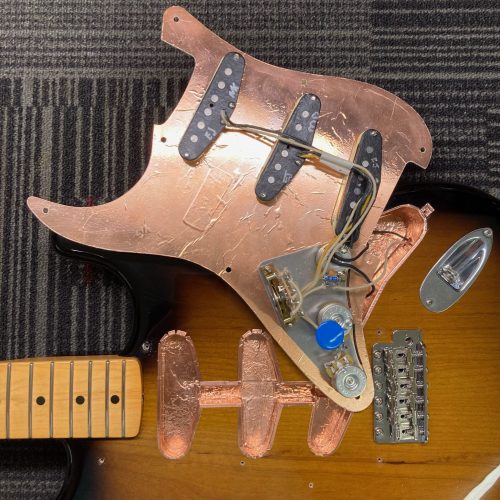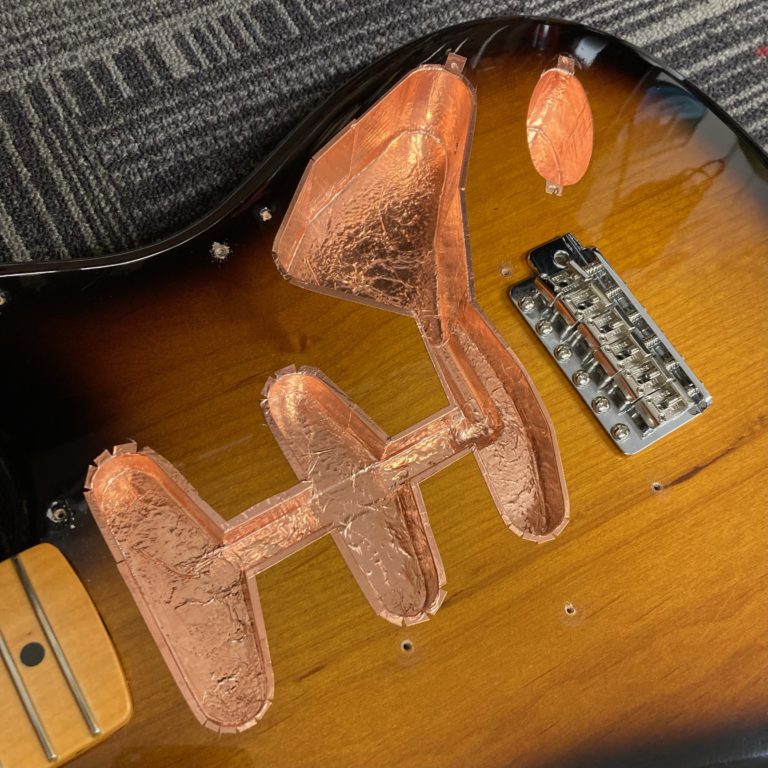Shielding An Electric Guitar

What Is Shielding?
“Shielding” is tool that is used to reduce electromagnetic interference, or “EMI”, in your guitar’s signal. Since most electric guitar pickups are by definition “electromagnetic transducers”, EMI is a frequent cause of unwanted noise in the guitar’s signal chain. Guitars with single coil style pickups are especially prone to these issues. (For a primer on both EMI and the concept of “grounding” in electronics, please checkout our article on string ground wires.)
For a bit of history, the theory behind the technique employed is based on a discovery by scientist Michael Faraday in the early 1800’s. He found that forming a continuous covering of conductive material around an area would block electromagnetic fields from entering the enclosed space. As such, electronic shielding is sometimes referred to as a “faraday cage”.

Pickups with metal covers, such as those commonly found on humbucking style pickups like the one pictured, are an excellent example of shielding at work.
The metal cover and pickup baseplate (the baseplate tab is visible on the left side of the photo) surround the pickup’s coils on all sides. This metal enclosure is then connected to ground via the pickup’s shielded wire, effectively creating a Faraday cage, preventing electromagnetic interference from reaching the pickup coil.
Humbucking pickups are also available without metal covers. While this is primarily an aesthetic choice, its absence does potentially reduce the pickups protection from EMI.
Guitar Cavity Shielding Types
The two common options for shielding a guitar’s control cavity are the application of special electrically conductive shielding paint or an adhesive backed metal tape.
We frequently see guitars that have been equipped with shielding paint inside of the control cavity at the factory; Shielding paint can usually be identified by a dull black appearance that doesn’t match the finish that is present on the instrument’s exterior. Unfortunately, almost without exception, testing with a multimeter reveals that the paint has not been applied thoroughly enough to create a proper conductive barrier.
In our shop, we strongly prefer metal shielding tape because it creates a solid barrier and is faster, cleaner, and less expensive to install. It is available in two varieties; Copper and Aluminum. The aluminum foil (no, not Reynold’s wrap) is silver in color while copper has a russet appearance, similar to that of a penny.
Shielding A Fender Stratocaster With Tape
Instruments that traditionally use single coil style pickups, such as the Fender Stratocaster, Telecaster, and Jazz bass are especially prone to EMI. Shielding is particularly important for these instruments if they are to be frequently used around lots of other electronics devices such as on a performance stage or inside of a recording studio.

In the photo, the strings and pickguard have been removed to reveal the control cavities of a Fender Stratocaster guitar. The pockets and channels shown have been routed into the instrument’s wooden body to house the electronic components.

We carefully line the floor and walls of the control cavities on all sides using sheets of copper foil tape with an adhesive backing. The foil has to be hand cut and pealed, piece by piece, until covered.
Since this lining is electrically conductive, it is important to work cleanly so as to minimize the risk of shorting the circuit once the electronics are been reinstalled.

Of course, the cage isn’t complete until we put a lid on it. While this particular pickguard is already pre-equipped with a piece of metal shielding near the switches and control pots, our goal is to enclose the electronics as much as is practical. To that end, we will shield the pickguard back in its entirety.
Once the pickguard has been reinstalled, none of this detailed work will be visible from the outside. However, the player will know that we have done our job by the reduced background noise coming through his guitar amp!

Static When Touching Guitar Pickguard?
Shielding the back of a guitar’s pickguard, and connecting it to ground, is also a great way to reduce the annoying static that players sometimes experience when their hand touches the pickguard during use.
My Guitar Is Shielded, But It Still Buzzes!
Shielding, will not eliminate the 60-cycle hum that is inherent to single coil pickup designs; For that you might consider replacing your guitar’s pickups with a humbucking or “noiseless” style design. Shielding also will not eliminate noise from sources further down the signal chain such as bad cabling, effect pedals, pedalboard power supplies, amplifiers, etc. In these cases, further troubleshooting may be necessary to isolate the cause of the noise.

Erik Salomon - Calico Guitarworks Owner / Head Technician
Tech Talk articles are part of an ongoing effort to provide clear and detailed answers to common questions about guitar maintenance, modifications, and repairs.
While not intended as a step-by-step guide to servicing your own instrument, we hope that you will find value in the information provided.

Great Repairs Start With The Right Parts
Many of the parts mentioned in our blogs are available for purchase at:
GuitarRepairParts.com
Enter the code "TechTalk10" at checkout for 10% off your first order.
About Calico Guitarworks
Calico Guitarworks is the area’s premier destination for fretted musical instrument care and maintenance. Owned and managed by Erik Salomon, the shop is dedicated to providing quick, honest and reliable service. The staff at Calico Guitarworks has a combined 25+ years of professional guitar repair experience. Sharing the knowledge that we accumulate in this focused pursuit is at the core of what we do. Learn more About Calico Guitarworks, explore our Frequently Asked Questions, or Contact us with a specific request.






